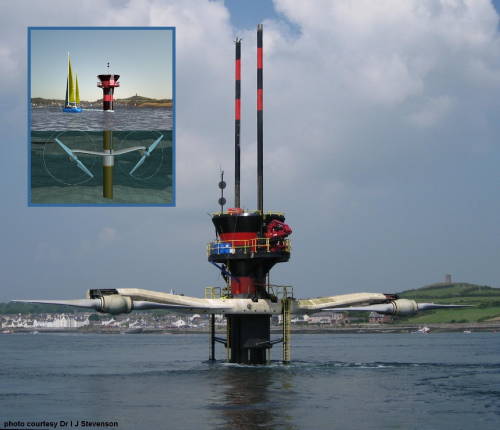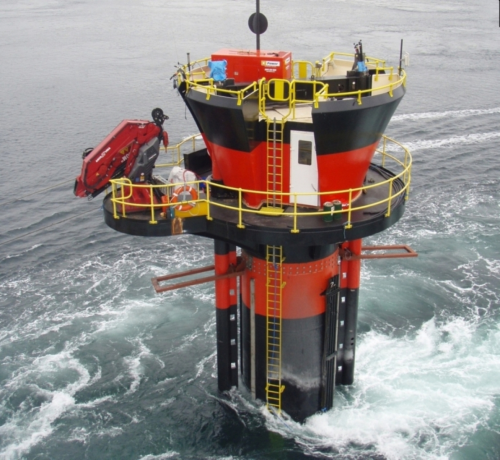

Dr Ralph Rayner, Sector Director, Energy and Environment at BMT Group Ltd explains why there has been so little progress in exploiting this vast renewable resource.
The biggest issue associated with exploiting marine renewable energy is the need to operate in a uniquely hostile environment. The huge potential that renewable energy offers is both an opportunity and a challenge because the areas where the greatest energy is available are the areas where it’s most difficult to engineer a means of exploiting that energy resource. The offshore marine environment is quite rightly considered to be one of the most challenging working environments on the planet.
The process of exploiting marine renewable energy can be broken down into a sequence of activities and hold-points. At each stage, offshore renewable energy installation developers need to draw on a range of specialist skills and services that may not be readily available in-house or might need to be developed expressly for a particular project.
Whether this involves measuring wind, tides, tidal currents or temperature distribution to determine the best location for an offshore renewable energy project or preparing environmental and navigational assessments as part of the formal consenting process, the importance of getting it right first time cannot be overstated.
Where to site offshore renewable energy
The first stage in the process is identifying where the best potential sources of energy can be found. An initial measurement and analysis exercise is required to identify where suitable resources are situated and how these sites map onto relevant coastal locations.
In the case of the UK, this involves identifying marine locations which have the best potential for offshore wind, tidal streams, or waves and then looking at how those optimum sites map onto existing infrastructure, grid connections and harbours or ports with the capacity to construct or support the infrastructure.
If the met-ocean data used to support the location of an offshore renewable energy project is flawed, it is possible that the facility will never be able to deliver the levels of energy required to make it commercially viable.
Competing interests
Having identified suitable resources and their proximity to physical infrastructure, the next stage is to investigate how the use of those areas for marine renewable energy might conflict with other uses.
| "...the marine environment is a busy place..." |
Despite its apparent vastness, the marine environment is a busy place with fisheries, defence needs and shipping - all key issues that must be considered.
Furthermore, proposed offshore renewable energy projects must take into account existing structures, submarine cables, oil & gas installations and a whole host of other maritime activities which must be accommodated without undue conflict.
Governments across Western Europe have recognised this and have established consenting processes that recognise the conflicting demands on ocean space. Understanding the issues involved and reconciling priorities between different demands is key to determining the suitability of an offshore renewable energy project at concept stage, long before any detailed design or construction takes place.
Consenting
In the UK the consenting process for the first three rounds of offshore wind development and the recent proposals for tidal stream installations in the Pentland Firth have successfully followed this rationale. The proposed tidal barrage across the River Severn where there are many conflicting demands and many environmental impacts associated with major engineering developments in the Estuary, is also being reviewed on the same basis.
From the developer’s perspective, having diligently undertaken the necessary studies and research to determine which sites are both feasible for development from an engineering and commercial point of view, and acceptable for development from an environmental point of view, all the evidence required to pass the formal consenting process should be available.
However, by partnering with a team which has the right expertise and experience in breadth and depth to support the developer through this stage will ensure that a complex requirement does not become unnecessarily onerous.
Design and construction – lessons from O&G
With a suitable location defined using robust data and with the necessary consents in place, the work of design and subsequently construction can commence. With offshore renewable energy projects now being developed further and further offshore, the experience that the industry has gained building onshore wind farms has less and less relevance, while lessons that companies such as BMT has learned in its work with the offshore oil and gas industry are becoming far more pertinent.
Massive structures designed to withstand the environmental forces prevalent in offshore locations require large areas of dockside to facilitate fabrication and storage. They also demand equally large pieces of specialist plant to transport and install them. Even the largest jack-up barges and installation cranes have a service wind speed and wave height beyond which they cannot operate.
Consequently the provision of robust hind-cast and forecast met-ocean data to allow accurate planning and then to define suitable weather windows is fundamental in optimising the construction period.
Operation and maintenance – the problem of access
Once an offshore renewable energy installation has been built and commissioned, the focus turns to how it can be supported in terms of operation and maintenance. There is an ongoing need for up to date met-ocean data so that energy outputs can be estimated to obtain the most favourable prices on spot markets.
In terms of maintenance, there is a fundamental difference between operating a plant in the marine environment and operating a plant on land. Generally, land based infrastructure in Europe is readily accessible for most of the year without huge constraints: In the sea this is not the case.
| "...the reliability of any mechanical plant installed on an offshore renewable energy installation must be very high if it is going to be commercially viable." |
Wind and wave conditions are seasonal but in offshore locations, wind and wave activity can limit access to offshore renewable energy installations at any time throughout the year. Consequently, operational planning issues and the provision of suitable plant and vessels are much more significant in the marine environment than they are on land.
Operational planning teams will require a wide range of environmental information to ensure optimisation of operation and maintenance. They will also need to safely deploy maintenance crews to offshore renewable energy installations up to 100 miles offshore.
This has precipitated the design and development of a brand new class of vessel that fills a gap in the market between unsuitable inshore craft and unacceptably expensive offshore oil and gas support vessels.
Because it is difficult to intervene easily at sea, the reliability of any mechanical plant installed on an offshore renewable energy installation must be very high if it is going to be commercially viable.
If a wind turbine on land breaks down in the middle of winter, it is still possible to affect a repair. If a wind turbine 50 miles offshore were to breakdown in the middle of winter, repair is much more difficult and might conceivably not be possible for perhaps months, due to wind strength and sea state.
For OREIs to be commercially viable a high degree of reliability must be engineered into all of the components of the installation.
End of life-time – then what?
One final factor that must also be considered, but has yet to be implemented due to the relative immaturity of the marine renewables sector is that of decommissioning.
The challenge currently facing the offshore oil and gas will be repeated. Potentially in 50 or 60 years time there will be thousands and thousands of turbines that have all reached the end of their working lives and will need to be either removed or fully refurbished.
| "There is no time to re-learn lessons of the past: We must get it right and get it right first time." |
However, with this knowledge and access to the lessons learned by the offshore oil and gas industry, offshore renewable energy installations can be deigned to ensure ease of decommissioning and removal. The challenges associated with removing these structures in the latter part of the 21st century can be considered and addressed almost before they are built.
There is certainly a steep learning curve for developers and operators of offshore renewable energy installations to go through. It is not simply a case of taking plant, machinery and working practices that are designed to operate on land and transposing them into the sea.
The oil and gas industry learned the hard way that it doesn’t always work and the offshore renewable energy industry need not follow the same path. Developers have the opportunity to work with companies like BMT that have experience in all the skill-sets required to provide through-life consultancy and support for offshore offshore renewable energy projects.
In order to support the step-change in design and construction that is so clearly required to meet our obligations under the 2009 Renewable Energy Directive, we must make the best possible use of the wealth of knowledge and experience available in the marine engineering, science and technology sector.
There is no time to re-learn lessons of the past: We must get it right and get it right first time.




